In a majority vote, the Patrick County Planning Commission found that Moscato LLC’s proposed plan for a solar farm was substantially in accord with the county’s comprehensive plan. The vote was 3-2 vote at the February 20 meeting.
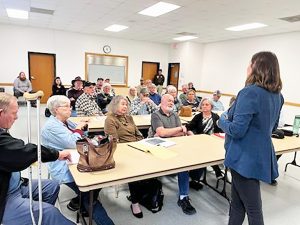
The proposal will be considered by the Patrick County Board of Supervisors at a later time.
Larry Cowley, Kurt Bozenmayer, and Cynthia Cowley voted for the motion.
Sarah Wray and Jane Fulk cast dissenting votes.
Larry Cowley said he voted for the motion as Moscato LLC’s plan is substantially in accordance with the comprehensive plan.
Cynthia Cowley said all the Planning Commission was to consider was whether the proposed plan was substantially in accordance with the county’s comprehensive plan.
“And I feel that they are,” she said, and voted in favor of the proposal.
Wray said she voted against the motion because she questions whether the project is in line with the county’s plan.
“After having this public hearing and having immense outpouring of information and lack of support from the community, I think it’s worth further exploration to make sure that if we’re given a document, their proposal should match our ordinance,” she said.
“I want to make sure that if we’re moving forward with the project of this scale with so much opposition that we feel very confident that we know that we’re doing so in accordance with the ordinances that we’ve set forth,” she said.
At the start of the meeting, Bozenmayer asked if there were specific concerns about the proposal’s compliance.
“And Sarah (Wray) mentioned a few of them beyond what my concerns were. I felt that for the most part when you look at all the paperwork that’s involved, their application is substantially in accordance,” he said.
But, Bozenmayer said there are some concerns that should be tried to work out before it goes for the final vote.
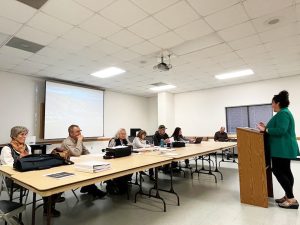
“Don’t take it to the supervisors as it is,” as substantially in accord, “but they should try to finalize these details to everyone’s satisfaction before it goes to the board of supervisors for their vote,” he said.
Fulk said she agreed with Wray about some of the things that need to be done.
“I’m not much on solar farms to start with. I know it’s part of our Green Energy, but” I felt it needed further investigation, she said.
Before the motion was made, Energix attorney Jasdeep Khaira, Esq. said the commission’s motion needed to include the phrase “substantially in accord.”
Khaira added the issues noted and addressing them will be done down the line.
Solar Meeting
At a meeting held by Energix on Monday, February 19, Dominika Sink, the company’s senior director of Project Development, said the global energy company has operations in the United States, Israel, and Poland.
“So far, we’ve invested about $1 billion in America’s energy infrastructure. We’re really proud of the work we do in the U.S., investing in U.S. energy grids,” she said.
Sink said Energix has developed, built, and operates over 600 megawatts throughout 15 different projects, predominately in Virginia.
Project Development Analyst Gracyn Draney said the Moscato project is just outside of the Woolwine community, with Woolwine Highway to the south and Pilson Sawmill Road to the east.
“The project is 13.2 megawatts. The equivalent of that in terms of powering homes is going to be 2,049 homes. We have a singular landowner for the project, and” that land is “currently not being used,” she said.
Sink said Energix anticipates using 120 acres of the land parcel, including land for the equipment, storm water controls, roads, setbacks, and other requirements. Metal beams will be placed into the ground with a wrapping system, with solar panels perched on top.
The beams “are spaced about 8 to 14 feet. Between those rows of solar panels, we have vegetation. That’s a requirement by the DEQ (Department of Environmental Quality), so essentially, it’s going to be a meadow with the solar panels on top of it,” she said.
At the planning commission meeting, Draney said the construction period will be about six months. Aside from the construction process, the project will not be loud or have long-term traffic or pollution. It will also be hidden behind a tree line, with a minimum setback of 50 feet.
“However, for our residential folks, the closest neighbor we have is 590 feet away. Our other neighbors have well over a 700-foot setback,” she said. “As we stated in the community meeting, for those neighbors who are concerned, we’re more than happy to work with you and with seeing if we can get more supplemental vegetation or what else we can do.”
In terms of revenue for the county, Draney said approximately $256,000 will be received in revenue in the first year.
Under the current land use for that project, “we would see a 62 percent increase for that tax revenue in year one,” she said.
For the 42-year lifetime of the project, the county would receive $2.4 million in revenue. Energix does not plan to change the panels out during the tenure of the project unless one is not performing correctly.
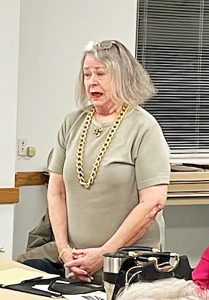
Draney said the plan will not impact surface water or groundwater resources, and will be outside of flood zones.
“In terms of economic benefits to the county, not only will the county have tax revenue, but also we like to work with local contractors. That is just another means of us providing” economic benefits for the county, she said.
Solar preserves the land for future uses, she said. At the end of the project’s lifetime, decommissioning the project means removing all above ground equipment.
To ensure that is done properly, Draney said no matter what happens, the company will issue a surety bond to the county.
“This is just one way to say, ‘no matter what happens, decommissioning will still occur.’ We have a third-party engineering company that helps with the decommissioning plan, so this is updated every five years to account for different factors, such as inflation or industry factors to make sure that number is constantly updating every five years,” she said.
The project will not introduce hazardous materials into the atmosphere, soil, or water, Draney said.
“We work with all of those state agencies to ensure that does not happen throughout the duration of the project,” she said, adding that Energix works closely with DEQ and invites it to all sites voluntarily.
“This is just one of our measures to make sure we are constantly in compliance with DEQ standards that are set forth. We go above and beyond,” she said.
Wray questioned the proposed project.
“I’m curious on the setbacks. You mentioned 50-foot, but our ordinance is set up as 75- foot for public right of ways as well as buildings and adjoining parcels,” she said.
Draney said this was one of the setbacks done with Fairystone Solar, LLC, another solar project in the county. She added that Energix is willing to take another look and work through the issue.
Doug Perry, vice-chairman of the Board of Supervisors and liaison to the commission, asked about the monitoring system for the panels.
“We have software that every module is connected to, so if there is anything that happens to the panel in terms of performance or damage, it’s immediately reported so that it can be fixed,” Draney said, adding the monitoring will be done remotely.
Several residents also spoke at the meeting, and asked questions of Project Development Analyst Danielle Corsan.
Mary Beth Clement, Debbie Foley, and Grant Foley spoke about the impact the project would have on the area’s view shed and potential impacts to tourism.
Clement said she wants to know if the comprehensive plan addresses the other economic impacts the project may have.
“The fact that this is going to be visible from Fred Clifton Park overlook and scenic overlooks from the parkway, it’s going to damage tourism in this county, which is the biggest economic driver that we have,” she said.
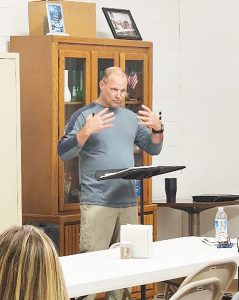
Clement asked whether the revenue the county receives from the project would replace the tourism dollars that will be lost, “because nobody is going to come here to go up on that mountain and stand at an overlook and see the solar panels. You can see that property right now from the overlook,” she said.
Foley said she knows the view shed is part of the comprehensive plan, and added that the reason tourists visit is because of the pristine and untouched land.
“This simple life, isn’t that our motto? If we wanted to have these types of things, let them go somewhere else where the grade is flat. My view shed … when you look at that, and we talked about this last night, if you look at my property it’s 700 feet, my mother-in-law’s is another 700 feet, and uncle’s is another 700 feet,” she said.
Foley said one important thing for people to remember is the area is in the hollow.
“My mother-in-law, 700 feet above us. Our uncle, 700 feet above her. When you’re coming down (Virginia) 8, as you’re going by this property, if you look across from where this project is going to be, you can see his house. He looks down on all of that,” she said.
Grant Foley said several of his neighbors also attended the meeting.
“We’re all on a hill, every one of us has hilltop property that’s going to be looking down on this. So, how high’s your vegetation going to grow to block the view of this,” he said.
He also questioned the company’s plan to keep the water from running off the hillside that goes directly into the creek.
“It’s already washing me away. I’ve lost three feet of creek bank since the gentleman clearcut his property. What’s it going to do when the whole hillside is cleared off,” he asked.
In terms of vegetation height, Corsan said evergreen trees that grow between one to three feet a year will be planted.
“If view shed is a concern, we can actually put the trees in before the site goes under construction so that it has a little bit of a jump start. I want to emphasize the site itself does have a really lush vegetative buffer already, however we are willing to supplement in areas that may be more sparse,” she said.
Erosion and sediment controls used are in compliance with those mandated by the DEQ, Corsan said.
“We actually go above and beyond what DEQ requires. Generally, the solar sites that we create actually have less runoff than they did before because there are measures in place. We absolutely do not want to have any runoff on any sites that might affect neighbors, it is against our interest to have that,” she said.
Grant Foley asked the commission if the meeting was a proposed contract negotiation or if the contract was already signed.
Larry Cowley, chairman of the commission, said the commission was doing all it is allowed to do, which was to determine whether the proposed plan was substantially in accordance with the comprehensive plan.
‘We have no authority other than that,” Cowley said.
“Well, I call bull crap on that because I’ve read the county ordinance, and it says the Planning Commission shall recommend or not recommend a proposal. So, y’all ought to be taking into account everything that the people here are saying, and you’re not. It’s falling on deaf ears. You’re rubber stamping,” Grant Foley said.
LeeAnn Seeley read a letter from Crystal Wood, who lives near the proposed solar farm location.
“I do not agree with this effort and cannot ever imagine this project being a part of my community and can in no way ever see it as a positive addition.
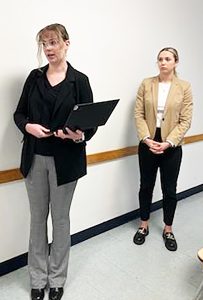
Wood said she sees no benefit for this environmentally using the toxic chemicals.
‘This very rural community has no place for something like this. We must keep this beautiful area untouched,” she said.
Seeley said she had asked about the risk of 38,372 degrading and potentially cadmium leaching solar panels in the proposed 42-year site to the local fishing communities.
“The answer that I got from Ms. Sink was no possibility of leeching,” she said. “So, for those that don’t know, cadmium telluride is what is used in these panels are toxic, which is considered hazardous by the OSHA (Occupational Safety and Health Administration) Communication Standard EPA National Institute of Health,” she said.
Corsan emphasized that cadmium and cadmium telluride are not the same thing, and are molecularly different.
“Cadmium is combined with telluride to create the compound, and this compound is stable. Cadmium will not leach into the soil or groundwater. The panels that contact the technology, these panels encapsulate and bind the technology so that it cannot escape. It is also not toxic,” she said.
Corsan used table salt as a comparison because it is also two different materials that are combined together to create something that is safe and stable.
“Again, there is no way that these panels naturally could ever leech. The only way to get them to, I guess, would be in a lab setting, and they use something called sulfuric acid, which is also known as piranha because it will take your hand off if you put your hand in a bucket of it,” she said.
Corsan said it’s an unnatural process used as part of First Solar’s, the solar panel manufacture, recycling process to reuse the semiconductor over and over again.
In terms of fire and potential wildfires, Corsan said the company is willing to work with local fire departments on training and first response.
“We use Tier I materials and roads on all our sites so that it can fit a firetruck. What we would do is monitor the panels remotely. If there was ever a case of a fire on site, the emergency services would be called immediately and react accordingly,” she said.
Materials in the panels would not go into the air, but rather be encapsulated in the panel glass. For example, she said there has been damage on a site in the Mojave Desert that is not an Energix project.
“That actually shattered over 100,000 panels. After the clean-up they tested the soil and there was no evidence of any cadmium or cadmium telluride on the soil,” she said.
Malcom Roach asked Corsan to stop with the comparison to salt, which “is a toxic substance. People stop and think you go to your doctor, does he tell you to take salt and use it? Every doctor would tell you to not to put salt in your diet. If you think salt’s not toxic,” get a few teaspoons “of it and put it in your goldfish bowl.”
“Mr. Roach, you did not sign up to speak sir,” Cowley said.
“I’ll just take one second,” Roach responded.
“No,” Cowley said.
“No, you will not,” Patrick County Sheriff’s officer Dustin Foley said.
“Are you the bouncer? Wow,” Roach asked.
Mary Smith said “this site is right beside Sycamore Baptist Church. My grandfather built that church. If I don’t fight against, I know Mike (McKenzie, the property owner), we used to be friends. He’s probably disowned me, but that’s okay. It’s important to me that we listen to the people and when we make decisions, we make decisions based on God’s direction, not just man’s.”
Ed Pool, who says he is a certified safety and health official with a present license by OSHA, posed a question to Draney.
“Dominika (Sink) made a very flat statement to the question by Richard Landis that you were involved in no litigation in the Commonwealth of Virginia. Do you still stand by that today,” Pool said.
Pool was referring to Landis, who at the community meeting said he saw the company was involved in a lot of lawsuits.
Landis said there are several counties in Virginia that are all having problems with Energix.
“To me, it seems that you have an inordinate amount of lawsuits against your company. What guarantees are you going to do for us, so we don’t get into the problems that all these other counties are in right now,” he said.
Sink said Energix is not in lawsuits by anybody or sued by the DEQ.
“In the normal course of construction there’s an inspection. If we’re not compliant, we would get a warning. If that doesn’t get fixed in this certain period of time, DEQ comes back with an inspection and they will issue a notice of violation, and that’s what we’re talking about,” she said.
Sink said there was a problem with a contractor on a project in Wytheville which created issues for Energix. The company does not work with that contractor anymore, and since that incident, Energix has started inviting DEQ to inspect its sites regularly.
“We opened the doors for DEQ. We want to be transparent, and we want to make sure our sites are compliant,” she said.
Sink said the vast majority of the violations Landis referenced were administrative.
“If you read the report, there is missing page numbers, a missing signature. A lot of these issues were administrative. Since then, we’ve worked with the DEQ, we’ve increased the number of dispatchers. They have the same experience as DEQ inspectors to make sure we catch those things early,” she said.
Landis asked what happened in Rockingham County.
“There were some issues there where you didn’t pay the contractor and, this was last year, they took out a mechanics lien on the contractor,” he said.
Sink said she was not aware of that, but “I can tell you that I know we’ve five contractors that didn’t fulfill their contracts, and if they put a lien we removed that lien on” behalf “of the landowner. I know that happened in Wytheville, I’m not familiar with Rockingham. All I can tell you is, yeah, we manage a lot of contractors in construction. Some of them don’t do things according to the scope in the contract,” Sink said.
Pool alleged Energix did not fulfill its obligation with the contractor in Wytheville.
“The landowner, a sheep farmer, had a $300,000 lien placed on his farm. That lien was lifted by the posting of two bonds, by Energix and Liberty Mutual I believe,” he said. “I can tell you the litigation is ongoing. As of today, I’ve checked with court. It’s not been settled, it is still in arbitration, the bonds are still in force,” he said.
Pool also spoke about cadmium telluride.
At the Wytheville site, Corsan said there was a contractor sequencing error for stormwater management during construction.
“What had happened is the contractor that we hired did not perform the stormwater management installation at the proper time,” she said, adding this led to some stormwater management issues on site.
Corsan said Energix took full responsibility even though it was a contractor error.
“We did stop working with that contractor immediately and therefore because the contractor did not fulfill their agreement with us properly, they were not paid. Therefore, there was a lien placed on our landowner, which we immediately lifted because we do value our landowners and we want to protect them at all costs.There is no ongoing situation at Wytheville, the lien is gone, there is no issues at Wytheville in terms of stormwater management or issues with the landowner there,” she said.
Vance Agee, who said he has a background in mechanical engineering and worked in the chemical industry for over 15 years, noted several submitted documents to the previous board of supervisors that state their opposition to the company and the technology entering into the county.
“We continue in opposition to this particular technology because cadmium telluride is on the top highly most toxic compound within the United States. What does that mean? For example, I think we’re familiar with black lung coal mines. We found out why and how it was caused,” he said.
Agge said cadmium telluride is well within the top of toxic compounds. “It’s a known hazard to human health and our environment. All the issues that are being voiced here, I think that is of the utmost importance to provide for a good decision.”
Corsan said the technology, the semiconductor cadmium telluride, Energix uses has been vigorously tested by reputable institutions as well as the United States government.
“It is considered a safe technology. Again, there is no risk of leeching, it can only be done in a lab setting. That is the only way that the panel can be broken down,” she said.
Stuart Town Manager Bryce Simmons asked if cadmium telluride was soluble.
“No, it’s not water soluble,” Corsan answered.
“So, how would someone be exposed to it as a toxic chemical,” Simmons asked.
Corsan said it would probably only be during the manufacturing process because it is not contained, “but all the panels that we use, it’s all encapsulated and contained. It would only ever be exposed to the air or environment in the manufacturing setting,” she said.
“You all are being very naïve if you can stand up here and say it will not happen,” Gail Spencer told Draney and Corsan. “Just because they’re testing in labs don’t mean something can’t happen. Never say never.”



